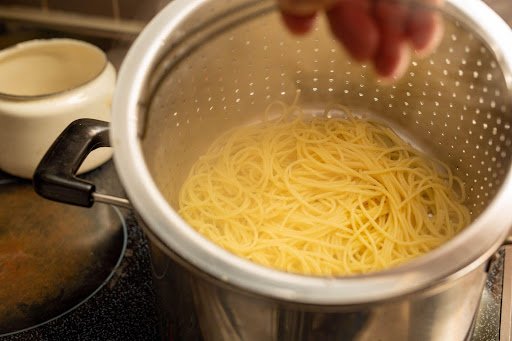
Percolator Definition: What is a Percolator?
A percolator is a type of coffee pot that specifically uses percolation to accomplish the coffee brewing process. Inside a percolator, heated water rises up a metal tube and is continually drawn downwards by gravity through a perforated basket. The perforated basket contains the ground coffee beans, which extract their essence directly into the coffee.
In this article, we’ll cover a few great percolator products, including:
- Best Commercial (Traditional) Percolator: West Bend Aluminum Coffee Urn
- Best Stovetop Percolator: Farberware Classic Stainless Steel
- Best Electric Percolator: Gastrorag
- Best Brand of Percolator Coffee: Jailhouse Coffee
Brewed Versus Percolated Coffee
The difference between ground coffee and percolated coffee is that percolated coffee tends to brew a stronger flavor because it is recirculated throughout the brewing process. In contracts, drip-brewed coffee runs through a filtered basket only once to provide a cleaner taste—but resulting in a brew that isn’t as strong.
How Does a Percolator Work?

Percolators are a well-known and often used method to brew coffee. They operate by sending heated or boiled water upwards using a tube that rises over the top of a perforated metal basket. From there, the water splashes over the coffee grounds, then trickles downward through the perforations in the basket and into the heated water to repeat the process.
With experience and good timing, most people that use a percolator can craft a strong flavor-rich cup of their favorite brew.
The term “percolate” refers to a continuous filtration process. Additionally, percolate can mean “spirited” or “lively,” like the visible bubbling inside the glass top available on some models. The benefit of the glass top in a non-automatic percolator is that users can view the changing color of the coffee and determine if it is ready.
Percolators come in two different forms: stovetop and electric. Carefully watch stovetop percolators continually while they brew your coffee. This way, you will know when to remove it from the stove.
If it remains on a burner too long, it will boil over, and could cause bitterness in your coffee. It may also subdue the distinct flavors, masking the notes in the coffee or even make it taste watered down.
Meanwhile, electric percolators generate consistent brewing by automatically stopping the percolation process. Most will revert to a warming mode once completed.
Make sure to thoroughly clean coffeemakers after each use to keep your brew flavorful each and every time.
Parts of a Percolator

A percolator coffee pot has several components. Cleaning them isn’t difficult—they come apart quite easily.
Cover Knob
This translucent plastic or glass knob helps users to view the color of their coffee. This is ideal on stovetop models, as you will need to see the brew color to determine if and when your coffee is ready.
This feature is unnecessary for electric percolators as they have a timer that stops the brew. Users do not need to monitor the process.
Spreader Cover
The spreader cover is made of perforated metal and has a hole in the center that a pump stem fits into. It should fit comfortably on the top of the basket.
Generally, it contains several circular rings and openings. These are specially shaped to provide a “shower” effect on the coffee grounds residing below. Additionally, it prevents the grounds from splashing up.
Basket
The basket contains a central tube or round opening that the pump stem will go through once inserted. Small holes on the bottom of the basket allow particles from the coffee grounds to remain in the basket while the liquid passes through.
You can optionally insert paper filters into the basket to smooth the taste. This allows for fewer coffee grounds to pass through while being infused.
Pump Stem
The pump stem is a long tube that rests in the middle of the pot, extending to the underside of the lid. It serves to support and hold the basket in place, and function as a non-mechanical pump—all making the coffee percolator pot work.
In a stovetop percolator, the pump stem is contained within the upper portion above the base. It may also sit within an established space inside the percolator. The base must always remain clean and damage-free for the coffee maker to work.
Up from the stem, you will note a protruding flange. This is where the basket goes. It keeps your basket in an upward position, and the pump stem points downward, providing a better seal.
How to Make Percolator Coffee

Steps to making coffee in a percolator depends on the type of device you are using. For some, the only time they make percolated coffee is in a group setting, which may involve an extremely large coffee pot. However, stovetop and electric percolators are both convenient options that require no filters and very little maintenance.
Both stovetop and electric coffee percolators make coffee differently. Here are a few things to be aware of:
Traditional Percolator
- By using the markings on the pot wall, fill the empty pot with water to your desired level.
- Insert the basket onto the pump stem and place them in the pot. Electric percolators will require the base of the pump to be seated properly and tightly into the cavity.
- Should paper filters be required, place them inside the basket.
- Place coarse coffee grinds into the basket. One tablespoon should be used for every cup of coffee, or according to your taste. Generally, it is 1 ½ tablespoons for a medium-strength coffee, with two tablespoons for one that is strong.
- Put the spreader cover over the top of the basket. Then, close the pot.
- Serve once brewed. If you will be serving it later, place the coffee in a thermal carafe to retain warmth and fresh taste.
Stovetop Percolators
For stovetop percolators, place your coffee pot over a burner at medium heat. If you are using a gas flame, keep the flame under the pot. When you can see the preferred color of coffee through the window, then remove it from the heat. You are now able to serve it.
Electric Percolator
For electric percolators, plug the power cord into an outlet. Adjust the coffee strength by controlling the amount of grounds and water in the percolator, then turn it on. The coffee pot will cease brewing once finished. Most electric percolators will remain on to keep the coffee hot.
How to Use a Percolator

Some expert tips on how to use a percolator include:
- Heating the coffee pot slowly waiting for it to begin to peak.
- Reduce heat towards the end so water is nicely heated, but not boiling or simmering. Steam should not be seen coming out from the percolator.
- Coffee should be percolated for seven to ten minutes for the perfect brew strength.
- Allow the coffee to sit two minutes before serving. This allows grounds that have made their way into the coffee a resting period. They will settle in the bottom of the unit and usually avoid the coffee cup.
- For best taste, use freshly ground coffee beans. Avoid a dark roast as it may be too strong. Instead, select one with low acidity such as light roast, mild, or smooth.
- Coarse grind your beans to avoid them falling into the coffee cup.
Coffee Percolator
While there are several different types of percolators, stovetop and electric are easier to brew. But there are multiple types of percolating coffee pots that are both useful and appealing.
Percolator Coffee Pot
Best Commercial (Traditional) Percolator: West Bend Aluminum Coffee Urn

This coffee urn is NSF certified with quick brewing. It will brew one cup of coffee, per minute making it ideal for large gatherings. It also has an indicator when brewing is finished. Automatic temperature controls keep coffee hot for hours, and it has a two-way dripless spout for serving.
Pros:
- Water markings on the interior make filling easy
- Filter basket has a cool tip to remove grounds
- Aluminum material makes it durable
Cons:
- Spout it too low, so the coffee pot needs to be positioned on the edge of a table
- Water may be too hot when poured
Best Stovetop Percolator: Farberware Classic Stainless Steel

Classic in appearance and function, users can make 4-12 cups with this stovetop percolator. The heavy-duty stainless steel creates the perfect finish, and the clear glass knob allows you to see when it begins to percolate.
Pros:
- Has a permanent filter basket, so filters are not required
- Dishwasher safe
- Interior doesn’t absorb odors or tastes
Cons:
- Lid fits too tightly to the pot making it difficult to remove
- Glass knob may break
Best Electric Percolator: Gastrorag

This stainless-steel percolator makes four cups of coffee in less than a minute. The indicator light shows when the coffee is ready.
The stay warm mode keeps the coffee hot and prevents it from becoming bitter. The handle offers a precision no-drip spout preventing users from spilling its contents.
Pros:
- Doesn’t absorb flavors
- Stay-cool bottom component won’t burn surfaces
- Filter chamber and tube can be placed in the dishwasher.
Cons:
- Last cup has grounds in it
- Lid sometimes comes off
Percolator Coffee
As mentioned, when it comes to coffee, stick to a medium roast, smooth, or mild blend. Only use a dark roast if you like an extremely potent cup of coffee.
Best Brand: Jailhouse Coffee

This medium roast offers a perfect blend of organic Peruvian and Mexican coffees. It has a hint of Sumatra creating a bit of sweetness with bits of citrus flavoring. It is USDA Organic Certified, Kosher, Fairtrade, and Non-GMO as well.
Pros:
- Consistent flavor
- Pesticide-free
- Grown in nutrient-rich soil
Cons:
- No negative reviews
Conclusion
Percolator coffee pots offer a very strong, rich, and flavorful experience for the coffee connoisseur. The taste is markedly different over drip-dried or other methods of coffee making.
They are designed for those who love coffee with bold flavors as it fully extracts the taste. Easy to use, they are very convenient when you desire to make an aromatic cup of coffee.








